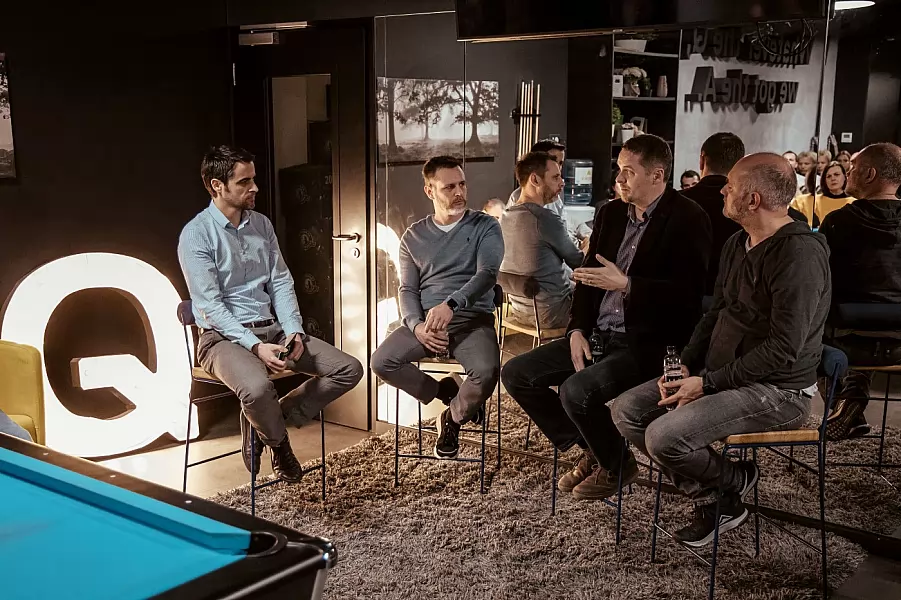April 7, 2020 - 4 min
Agility as a “buzzword” or useful business philosophy?

Agile meetup in Q announces a turnaround in business
Q has recently organized, in collaboration with the Agile Croatia Meetup, a record-breaking event on the topic of “Agile Perspectives” in their Zagreb headquarters. The panel discussion was attended by more than 100 experts and young innovators involved in the agile community, as well as those who are yet to discover the potentials of this approach in business.
This type of project management is a trend in many industries around the world today. Compared to traditional business understandings, agile means flexibility, adaptation and revision of short-term goals against long-term and strictly defined plans. We can say for agility that it is actually the attitude, the mindset and ultimately, the culture of a company.
Agile transformation across industries has been revealed to us by panelists who have successfully implemented this methodology in their business environments. First of all, Nikola Zinic (Creative Director at Bruketa&Zinic&Grey), then Dalibor Jurgec (Co-Founder of Q), and Mladen Baresic (agile coach from Zagrebacka banka). The panel moderator was Josip Barisic, who is also leading the new agile education in Q.
“We have exposed attitudes and practices from a financial, marketing and IT perspective to answer various questions such as the prerequisites necessary for the success of an agile transformation, what are the motives for the transformation, what are the reasons for failure, how large and smaller organizations behave through this transformation and many more. Although our panelists come from dierent industries, an agile approach to business, a constant change of culture, and partnerships with clients and employees, are the main features that are common to all “ — notes Josip Barisic.
Agile transformation involves changing the mindset

Nikola Zinic explained the reasons and motivation for entering the transformation: “It came naturally to us. The old model we had no longer gave us good results, we became sluggish, and the mode of communication changed. First we waited for the client to define the problems, then we waited for a brief from the client, which you then returned, redefined, etc. This is a “waterfall” or “ping-pong” approach. Our ultimate motivation was to be faster and more eicient. ”
Dalibor Jurgec emphasized that they have been working in an agile way for a long time: “There comes the time when you realize that you are agile, and then it needs to be formalized so that business processes and procedures can be developed. Agile mode should be tailored to your needs by first changing your company-wide mindset. In the end, it’s important to deliver what the customer wants, not what you think he wants. Help him get what’s best for him at that moment. “
“One cannot start doing this mode overnight. You may not have enough capacity to monitor change, and the opportunity to truly learn can be easily missed. It is important to start slowly and slightly raise the ladder and expand the range of activities, ”said Baresic, an agile coach at Zagrebacka banks.
“We turned to Agile when we realized that we had problems with the complexity and culture of the organization, which was most evident in the diiculty in prioritizing and implementing project initiatives and in some of our communication patterns,” Baresic adds.
When asked why agile fails in some systems, Zinic replies: “Generally, I think it’s a question of the mindset of people. Younger companies are more successful in this, they have grown up in an environment that is part of their culture, unlike companies with a long history. People are not used to failing, and then learn from it. Let’s say we work with Coca-Cola, which is a large system for two years in an agile way. They are very fast now and they are making a quick decision. ”
Today’s business depends on its ability to react quickly and adapt to its environment

Expert Traveler is one of the agile projects of Q with which they started the transformation. Through this collaboration, they have developed a travel platform for NewsUK, one of the UK’s largest publishers with several well-known brands such as The Sun and The Times, which today oers travel services to audiences across the UK through Q’s web solution.
“The project itself was specific, we had various challenges that we faced. From a very short deadline to developing the whole idea and business solution, changing the Product Owner by the client, learning and learning about the methodology, and finally the special challenge of breaking into the saturated marketing market.
We started the initial phase of the project through a workshop with a client, then we did a discovery phase which allowed us to create business logic and solutions. We then defined user stories and continued to develop design & development through biweekly agile sprints. The added value of the project is certainly obtained through quality feedback from the client as well as from the actual users. The focus on results has enabled us to achieve the project on time, and through communication and transparency we have achieved excellent cooperation ”- Dalibor Jurgec further explains the agile process in Q.
“If one chooses to be agile, it should go full heart. Some see agile as light at the end of the tunnel, but this is not the solution to all problems. It needs to be persistent, changing and adapting, because business ultimately depends on adaptation. Ultimately, we all need to speak the same language, which is why in Q we focused on education and training for agile mode. This panel is just the beginning, and with great interest, we will definitely plan the next event already in the spring ”- finally says Dalibor Jurgec.

Give Kudos by sharing the post!





